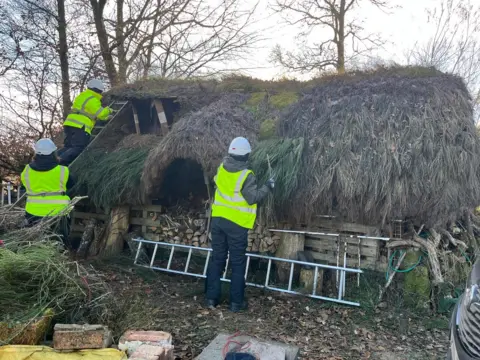Critically endangered crafts fight extinction
 BBC
BBCCraftsman Scot AnSgeulaiche weaves together a roof with broom and heather handpicked from just outside Muthill in Perthshire.
He's one of the last Highlands and Islands style thatchers in Scotland.
"We have somewhere in the region of a couple of hundred thatched properties in the Highlands and Islands style," he said. "You could decide that they're not at all historically culturally valuable and we could just put them down to slates and tin or you could say that's part of our culture and we do think it's valuable. I happen to think it is."
Thatching is one of a number of critically endangered crafts and he's currently working with a group from Historic Environment Scotland showing them the skills from the past to make sure they have a future.

"I think it's important. I think it tells us something about who we are," he says.
The critically endangered category means they are on the verge of extinction because there are very few practitioners or trainees left for skills to pass on.
The Red List of Endangered Crafts was created in 2017 by the national charity for traditional heritage crafts - Heritage Crafts.
Crafts are ranked from viable through endangered to extinct.
The idea was borrowed from the international Red List of endangered species.
Mary Lewis is head of craft sustainability at Heritage Crafts.
She said: "We're worried that crafts could become extinct but we're mostly worried about the reduction of opportunities for people to practice these crafts. We feel everybody should have the opportunity and access to practice these crafts.
"And particularly in Scotland, where we have some crafts which are of real cultural significance and importance to Scotland," she added.
 Euan Myles
Euan MylesThe warning from Heritage Crafts is that the skills and knowledge of these crafts could be lost if they are not passed on to the next generation of makers. They have been funding training and raising awareness to make sure this doesn't happen.
Orkney chairmaking is on the endangered list.
Kevin Gauld makes traditional Orkney chairs as well as other pieces of traditional Orkney furniture.
"Orkney chairmaking is very important to Orkney. It's such a unique piece of furniture and has been made for generations and it's still being made today. The chair really tells the story of people, place and time."
He feels optimistic about the future.
"At the moment we feel that it's in quite a safe place, but we could always do with the younger generation coming in to keep the craft viable for the next generation."
 Lily Smith
Lily SmithSilver spinning is also on the critically endangered list.
Lily Smith is one of the last people to learn how to spin silver in this country.
It is the process of shaping flat silver into a hollow item using a lathe.
She said: "I think it would be a lie to say I don't feel that pressure on my shoulders. I really love the craft and I think it's important and I think there's a lot of pressure to keep it alive, especially being one of the last."
Heritage Crafts will unveil the next Red List in May. It will not only show which crafts have become more endangered or disappeared but also which ones have managed to successfully increase their numbers.
